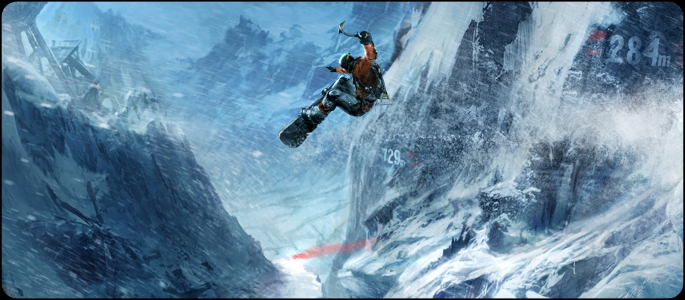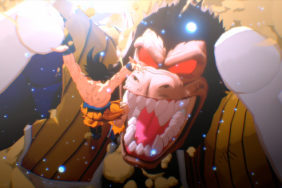
We have yet to see an SSX game on all current consoles this generation. Sure, we’ve at least received a snowboarding game in the form of Shaun White, but that was average at best, and fans of the SSX series have definitely been pining for the next arcade rush that is the SSX series. Enter SSX: Deadly Descents (working title). While parts of the game do take a darker turn, the SSX of old is also making a return, with plenty of new features to bring in new gamers. We got our hands on the game while at E3, and have our thoughts after the break.
At the enormous EA booth tucked in the north-western corner of E3 (the badges we were handed included a map!), the two-roomed booth featured first a ten-minute play-through demo, followed by a ten-minute demo session. During the play-through session, we sat through the three main modes SSX offers – “Race,” “Trick” and “Survive.” Before we got into the thick of things, however, the new dynamics of the game were unloaded onto us.
First, we were notified that the game was being shown off in a pre-alpha state, which is rare for an EA game at E3. The team has developed a new level generation technology which sounds unprecedented compared to any other downhill game, snowboarding-related or not. The system can take topographical information from NASA, and essentially take the input the GPS coordinates of any mountain around the world. From there, a model of the mountain consisting of at least 100,000 polygons can be constructed in only 28 seconds. So this allows for the development team to stop focusing on re-creating a mountain by hand and focus instead on crafting fun rides down the slopes. In one example given, a real-life mountain lies between the border of China and a neighboring country. The developers took a liberty with this fact and placed the Great Wall of China on this mountain, and the player can grind said wall. So essentially this level technology allows for more time for the team to stretch their creative muscles when creating courses.
Up next was the first of the core three modes of SSX: “Race.” This was pretty much as the name implied – a race to the bottom of a course. In this case, however, the course was Mount Kilimanjaro, which is essentially a massive inactive volcano. So what better place to start the demo than the mouth of one of the openings of said volcano? In EA Canada’s vision of the volcano, the internal structure is a snowboarder’s paradise, with multiple interconnected paths for every rider to choose from. It was fast-paced and reminiscent of an HD version of SSX.
The next mode, “Trick,” involved a single boarder given the chance to score as many points as possible on the way down the mountain. A “Tricky” meter fills up over time depending on the rhythm of your ride – continue to land multiple tricks successively and the bar (and multiplier) goes up, and vice versa. It culminates in your rider creating massive aftershocks that stem outward from him or her, temporarily deforming the terrain around them in a pretty nifty effect. The ground does return to normal immediately afterwards, however, so it seems to serve more of an indication that you are in a good rhythm of tricks than anything else. It is a cool effect, however since the game is so early in development who’s to say what will come of it.
Last but most certainly not least, we saw a small sample of the “Survive” mode. This is the mode that the announcement trailer was representing. The physics engine applied to the snow can do more than just accurately map a mountain based on NASA’s data. It can apply stability maps to that snow as well. What this means is that you can cause avalanches – but not all the time. This “Survive” mode starts you off near the top of mountains, the only mode that does this; according to the developer when you get near the tops of mountains the terrain is much less fun for the other modes. For example, if you carve along some snow and it comes loose, an avalanche may be triggered. If, however, there is a patch of flat, and therefore relatively stable, snow, it may end up stopping the previously dislodged snow from triggering an avalanche. In the example we saw, the player of course started an avalanche. It quickly snowballed into a level 1 avalanche and was fast approaching a level 2 before he was slammed against a cliff and the game was over. The camera took a swing to an overhead view, with the player zooming towards the bottom of the screen and mountain. It was very tense, and looks to bring a measure of excitement the series has yet to see.
After these game modes were demoed for us, we were led into another, slightly smaller room to the right. There we got our hands on the “Trick” mode to try for ourselves. The controls are a pretty standard affair – left analog stick to move the boarder, face buttons to initiate tricks. You can tweak these tricks with the right analog stick, and combing this with moving the left stick can rotate and flip your boarder. L2 is used to grind “anything pointed.” The especially well-handed among us can grab the board with the circle button, tweak it with the right stick and turn/flip with the left stick. You can pull off some great-looking tricks with relative ease, and landing is pretty simple. It’s all about timing – it doesn’t seem to matter your boarder’s orientation, as long as you release the trick at the right time you will land basically every time. After three runs I had gotten the hang of the game enough to achieve a gold medal on the level, so this is looking to be a mode that almost anyone can play.
While I would have liked to have gotten time with the other two modes, unfortunately that was not available to try here. But based on what I saw at the demo, the series seems to be headed in a good and refreshing direction. I came into the demo quite cautious, and left with a want for more time with it. Knowing the game is in a pre-alpha state and yet is already this presentable is also promising for things to come.








